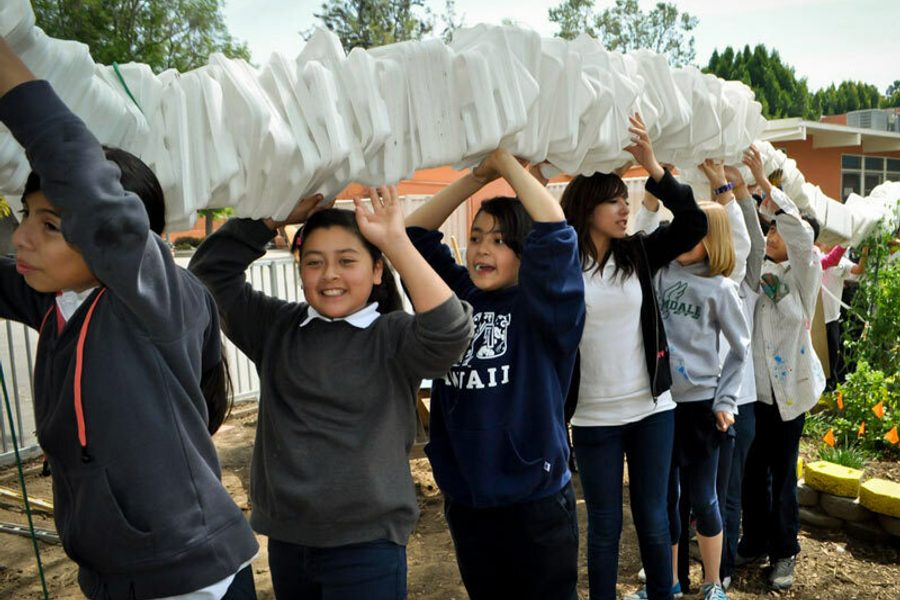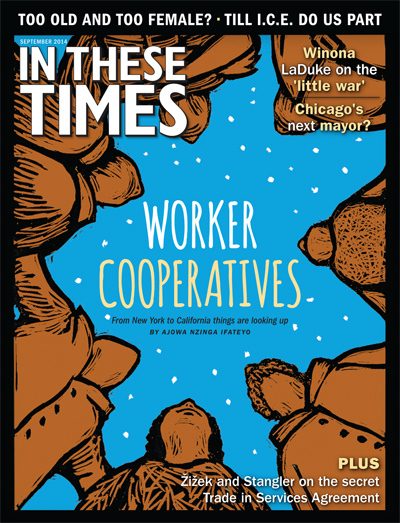Foam Wasn’t Built in a Day
Eco-activists of all ages are working to banish styrofoam.
Molly M. Ginty

It started with trash talk.
In 2010, as part of a project on the environment, sixth-grade teachers in Silver Lake, Los Angeles asked their students to carry around their personal trash in loose bags for a full week in order to study how much garbage they generated. By the end of their experiment, the students at Thomas Starr King Middle School were stunned by how much of their garbage was comprised of Styrofoam, much of it coming from their own school cafeteria.
So in 2011, to demonstrate how much Styrofoam waste their school produced, teacher Ann Holtzinger’s students built a giant Styrofoam “snake” made up of 1,260 lunch trays — about the same as the number thrown away in their cafeteria every day. As the snake grew to overtake the garden adjoining their school, they demanded their lunchroom switch to eco-friendly trays. In 2012, three years into a campaign that was joined by other students, parents and teachers, they helped convince the Los Angeles Unified School District (LAUSD) to ban Styrofoam in all 900-plus of its schools. The second largest school district in the nation, LAUSD now uses paper trays that are 3 to 4 cents cheaper than Styrofoam ones, saving the district $5 to $6 million per year.
The LAUSD ban is part of a growing movement to eradicate polystyrene foam products (the generic name for the thermoplastic petrochemical that we know as Styrofoam). Chicago public schools are phasing out polystyrene foam, and many major cities—including New York, San Francisco, Minneapolis, San Jose, Seattle, Portland, Oregon, and most recently, Washington, D.C. — have joined the anti-Styrofoam crusade, usually by banning single-use Styrofoam clamshell containers, but sometimes by outlawing Styrofoam cups and packing materials, too. Pushing for these bans are both national advocacy groups (such as Clean Water Action) and local ones (such as Save the Bay, an Oakland-based nonprofit that has joined Clean Water Action to lobby for Styrofoam bans in California). Nearly “100 towns, cities and counties around the United States have banned Styrofoam containers, with most of that happening in the past five to ten years,” says Eric A. Goldstein, a senior attorney at the Natural Resources Defense Council in New York City.
Why shun Styrofoam? Though it’s lightweight, flexible and insulates well, it can in fact be toxic to wildlife and humans. Made with benzene, a carcinogen linked to neurological problems, Styrofoam can ooze toxic chemicals into hot foods—and into the air when it is burned. U.S. citizens have used so much Styrofoam since it was introduced by Dow Chemical in 1941 (we now toss out an estimated 25 billion Styrofoam cups per year) that it has leached into our soil and water — and virtually all of us have styrene, a key component of Styrofoam, lurking in our body fat.
Humans aren’t the only ones being affected. Because it’s not fully biodegradable, polystyrene piles up in landfills, taking an estimated 500 years to breakdown. Because it’s lightweight (comprised of more than 90 percent air), it can be picked up and carried by wind and water and pollute widespread areas. After littering or accidental dispersal from landfills, it mounts up in storm drains, streams, rivers and beaches. Pebble-sized, brittle pieces of eroded Styrofoam look like food to birds, fish, turtles and other animals, which ingest them — and often die.
As a solution to such environmental problems, Styrofoam manufacturers and producers say what’s needed is better recycling (just 1 percent of Styrofoam is currently recycled, compared to an average of about 10 percent of other plastics). “There are drop-off locations, and curbside recycling that is being implemented by many cities,” says Michael Westerfield, a spokesperson for Dart Container Corp., the world’s largest manufacturer of polystyrene foam cups.
But officials in communities where Styrofoam has been banned say that recycling has not proven to be feasible. “Styrofoam containers have to be perfectly clean before they [can be recycled],” says Andrew Johnson, a member of the Minneapolis City Council, which banned Styrofoam in the early 1990s and moved to strengthen that law with a new, stronger measure this year. “Since the market for Styrofoam is shrinking, it’s not currently economical to recycle because you have difficulty recouping costs with sales,” he adds.
So what’s the alternative? Local and national activists are lobbying for compostable containers (as opposed to biodegradable ones). “Compostable options break down within 180 days, and leave no toxic residue behind,” says Ari Patz, the executive director of Styrophobia, a Honolulu-based advocacy organization. “They come in two basic forms: fiber containers made of either wheat straw or sugar cane, and paper containers with plant-based liners as opposed to petroleum-based ones.”
But compostable containers may prove to be a hard sell. They don’t insulate food as well as Styrofoam ones, though scientists are working to address this problem as they develop new packaging materials. And they also cost consumers significantly more than biodegradable containers, such as those used in LAUSD. Compostable clamshell containers cost 20 to 35 cents each, compared with 8 to 16 cents for Styrofoam containers, according to Patz.
The American Chemistry Council, an industry group based in Washington, D.C., maintains that this cost is too high for the food industry to bear. In cities considering Styrofoam bans, its lobbyists have argued that a mandatory switch could squeeze restaurants — especially small, mom-and-pop establishments — out of business.
“Restaurants are balking at these changes, and their finances are a concern,” says Goldstein. “But most places that are banning Styrofoam are working to make the transition as slow and affordable as possible, typically through gradual phaseouts.” For example, the D.C. Styrofoam ban, which passed the City Council in June thanks to an aggressive push by Mayor Vincent Gray, won’t go into full effect until 2016.
In San Jose, which banned Styrofoam containers in 2013, independent analysts found that banning Styrofoam would increase most restaurants’ costs by less than 1 percent, says Paul Ledesma, an environmental services administrator for the San Jose government. “It’s minimal, but still, we’re making accommodations so that sacrifice will be easier to bear,” explains Ledesma. “We’re allowing nonprofits that serve food to the needy to continue using Styrofoam trays. We’re allowing restaurants to file for financial-hardship exemptions. And we’re holding meetings with restaurant owners to show them how to make this switch.”
Finding alternatives to Styrofoam has become easier since major restaurant chains — including McDonald’s, Dunkin’ Donuts and Jamba Juice—have moved to ban Styrofoam from their franchises in recent years. Newfangled biodegradable and compostable containers are seeing wider distribution, and a boom in sales.
Even so, the fact remains that manufacturers are churning out 280 million tons of new plastics every year, and plastic pollution is causing an annual $75 billion of damage to the environment. The Great Pacific Garbage Patch, a mass of Styrofoam and other debris reputed to be larger than the state of Texas, is floating — and growing — off U.S. shores. Tons of polystyrene also lurk in Arctic sea ice, which, when and if it melts due to global warming, could unleash a flood of plastic into the environment.
“I predict that Styrofoam containers will be phased out, community by community, within the next decade or so,” says Goldstein. “But because this material takes centuries to break down, its legacy will still be with us for a longtime to come.”








